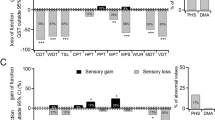Abstract
This study evaluates the additional use of laser-evoked potentials (LEP) and quantitative sensory testing (QST) in the sensory assessment of spinal lesions. Four consecutive patients with spinal lesions verified by MRI and clinical evidence for mild spinothalamic tract involvement were included. The electrophysiological workup [somatosensory evoked potentials (SEP) and LEP] was compared to QST. Electrophysiology and QST were reassessed after about 6 months. LEP detected impaired spinothalamic tract function in 7/8 examinations. QST pointed to spinothalamic tract lesions by loss of thermal function (3/8); most frequent positive sensory signs (3/8) were paradoxical heat sensations. LEP and QST results were concordant in 6/8 examinations. SEPs were abnormal in 2/8 examinations. Congruent results between SEP and both LEP and QST were obtained in 3/8 examinations. LEP detected more deficits than any single QST parameter or their combination but additional QST allows the detection of positive sensory signs. The diagnostic gain of SEP was limited.



Similar content being viewed by others
References
Krishnan C, Kaplin AI, Pardo CA, Kerr DA, Keswani SC (2006) Demyelinating disorders: update on transverse myelitis. Curr Neurol Neurosci Rep 6(3):236–243
Nair KP, Taly AB, Rao S, Murali T (2001) Afferent pathways of sympathetic skin response in spinal cord: a clinical and electrophysiological study. J Neurol Sci 187(1–2):77–80
Kakigi R, Shibasaki H, Kuroda Y, Neshige R, Endo C, Tabuchi K et al (1991) Pain-related somatosensory evoked potentials in syringomyelia. Brain 114(Pt 4):1871–1889
Treede RD, Lorenz J, Baumgartner U (2003) Clinical usefulness of laser-evoked potentials. Neurophysiol Clin 33(6):303–314
Iannetti GD, Truini A, Galeotti F, Romaniello A, Manfredi M, Cruccu G (2001) Usefulness of dorsal laser evoked potentials in patients with spinal cord damage: report of two cases. J Neurol Neurosurg Psychiatry 71(6):792–794
Rolke R, Baron R, Maier C, Tolle TR, Treede RD, Beyer A et al (2006) Quantitative sensory testing in the German Research Network on Neuropathic Pain (DFNS): standardized protocol and reference values. Pain 123(3):231–243
Eberle T, Doganci B, Kramer HH, Geber C, Fechir M, Magerl W et al (2009) Warm and cold complex regional pain syndromes: differences beyond skin temperature? Neurology 72(6):505–512
Lang PM, Schober GM, Rolke R, Wagner S, Hilge R, Offenbacher M et al (2006) Sensory neuropathy and signs of central sensitization in patients with peripheral arterial disease. Pain 124(1–2):190–200
Cruccu G, Anand P, Attal N, Garcia-Larrea L, Haanpaa M, Jorum E et al (2004) EFNS guidelines on neuropathic pain assessment. Eur J Neurol 11(3):153–162
Spiegel J, Hansen C, Baumgartner U, Hopf HC, Treede RD (2003) Sensitivity of laser-evoked potentials versus somatosensory evoked potentials in patients with multiple sclerosis. Clin Neurophysiol 114(6):992–1002
Polman CH, Reingold SC, Edan G, Filippi M, Hartung HP, Kappos L et al (2005) Diagnostic criteria for multiple sclerosis: 2005 revisions to the “McDonald Criteria”. Ann Neurol 58(6):840–846
Treede RD, Lankers J, Frieling A, Zangemeister WH, Kunze K, Bromm B (1991) Cerebral potentials evoked by painful, laser stimuli in patients with syringomyelia. Brain 114(Pt 4):1595–1607
Treede RD, Jensen TS, Campbell JN, Cruccu G, Dostrovsky JO, Griffin JW et al (2008) Neuropathic pain: redefinition and a grading system for clinical and research purposes. Neurology 70(18):1630–1635
Treede RD (1994) Evoked potentials related to pain. In: Boivie J, Hansson P, Lindblom U (eds) Touch, Temperature, and pain in health and disease: mechanisms and assessments. Progress in Pain Research and Management, vol 3. IASP Press, Seattle, WA, pp 473–489
Mauguiere F, Allison T, Babiloni C, Buchner H, Eisen AA, Goodin DS et al (1999) Somatosensory evoked potentials. The International Federation of Clinical Neurophysiology. Electroencephalogr Clin Neurophysiol Suppl 52:79–90
Cruccu G, Aminoff MJ, Curio G, Guerit JM, Kakigi R, Mauguiere F et al (2008) Recommendations for the clinical use of somatosensory-evoked potentials. Clin Neurophysiol 119(8):1705–1719
Brooks DJ (1998) The early diagnosis of Parkinson’s disease. Ann Neurol 44(3 Suppl 1):S10–S18
Herholz K (2003) PET studies in dementia. Ann Nucl Med 17(2):79–89
Nociti V, Cianfoni A, Mirabella M, Caggiula M, Frisullo G, Patanella AK et al (2005) Clinical characteristics, course and prognosis of spinal multiple sclerosis. Spinal Cord 43(12):731–734
Greenspan JD, Ohara S, Sarlani E, Lenz FA (2004) Allodynia in patients with post-stroke central pain (CPSP) studied by statistical quantitative sensory testing within individuals. Pain 109(3):357–366
Siddall PJ, McClelland J (1999) Non-painful sensory phenomena after spinal cord injury. J Neurol Neurosurg Psychiatry 66(5):617–622
Woolf CJ, Bennett GJ, Doherty M, Dubner R, Kidd B, Koltzenburg M et al (1998) Towards a mechanism-based classification of pain? Pain 77(3):227–229
Acknowledgments
This work was supported by the “Deutsche Forschungsgemeinschaft” (BI 579/1 and 579/4; Tr236/13-4), the “Bundesministerium für Bildung und Forschung” (DFNS; grant: 01EM0506), the “Kalkhof-Rose-Stiftung” and the “Arbeitsgemeinschaft für Krebsbekämpfung der Träger der gesetzlichen Kranken- und Rentenversicherung NRW”. Thanks to G. Schatt for expert technical assistance.
Conflict of interest
The authors report no conflict of interest.
Author information
Authors and Affiliations
Corresponding author
Rights and permissions
About this article
Cite this article
Geber, C., Baumgärtner, U., Fechir, M. et al. Comparison of LEP and QST and their contribution to standard sensory diagnostic assessment of spinal lesions: a pilot study. Neurol Sci 32, 401–410 (2011). https://doi.org/10.1007/s10072-011-0476-9
Received:
Accepted:
Published:
Issue Date:
DOI: https://doi.org/10.1007/s10072-011-0476-9




